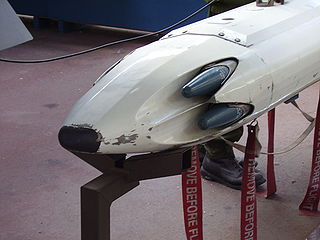 W
WThe CRV7, short for "Canadian Rocket Vehicle 7", is a 2.75-inch (70 mm) folding-fin ground attack rocket produced by Bristol Aerospace in Winnipeg, Manitoba. It was introduced in the early 1970s as an upgraded version of the standard U.S. 2.75-inch air-to-ground rockets. It was the most powerful weapon of its class, the first with enough energy to penetrate standard Warsaw Pact aircraft hangars. The CRV7 remains one of the most powerful air-to-ground attack rockets to this day, and has slowly become the de facto standard for Western-aligned forces outside the United States.
 W
WForges de Zeebrugge is an arms manufacturer in based in Herstal, Belgium.
 W
WPanzerblitz is a German anti-tank unguided aerial rocket developed during the Second World War.
 W
WCirit is a laser-guided 70 mm missile system under production by Turkish arms industry manufacturer ROKETSAN. It is one of the projects launched by Turkey to equip the Turkish Army's T-129 Atak, AH-1P Cobra and AH-1W Super Cobra attack helicopters with low-cost precision strike capabilities. It has been selected by Eurocopter for execution of a test and integration program to equip the Eurocopter EC635. The weapon's name comes from a traditional Turkish horseback game, Cirit, where two teams of riders fight a mock battle using wooden javelins which are called cirit.
 W
WThe RP-3 was a British air to ground rocket projectile used during and after the Second World War. The "3 inch" designation referred to the nominal diameter of the rocket motor tube. The use of a 60-pound (27 kg) warhead gave rise to the alternative name of the "60-pound rocket". Though primarily an air-to-ground weapon, it saw limited use in other roles. They were generally used by British fighter-bomber aircraft against targets such as tanks, trains, motor transport and buildings, as well as by Coastal Command and Royal Navy aircraft against U-boats and ships.
 W
WThe SNEB rocket is an unguided air-to-ground 68 mm (2.7 in) rocket projectile manufactured by the French company TDA Armements, designed for launch by combat aircraft and helicopters. It is also known as the SNEB rocket pod, and sometimes as the Matra rocket, due to it commonly being carried in pod-like launchers built by Matra.
 W
WThe Oerlikon-Bührle SNORA and SURA-D are 81-mm and 80-mm rockets developed in Switzerland in the late 1970s and fielded in the 1980s. The SNORA could be used in both air-to-surface and surface-to-surface rocket artillery roles, while the SURA-D is an air-to-surface rocket. The SNORA was developed as a cooperative endeavor with the Italian firm SNIA-Viscosa.
 W
WTDA Armements SAS was a French defence company, that made widely deployed air-to-ground rockets, and now a division of Thales Group.
 W
WThe UB-16 is a 57 mm, reusable, 16 round rocket pod developed by the Soviet Union in the 1970s for aerial use in close air support and ground attack situations. Typically, it is mounted on external aircraft hardpoints and fires S-5 rockets. The UB-16 has also been used in improvised manners on the back of armored vehicles and trucks, most recently in the Syrian Civil War and fighting in Libya.
 W
WThe UB-32 is a 57 mm, reusable, 32 round rocket pod developed by the Soviet Union in the 1970s for aerial use in close air support and ground attack situations. Typically, it is mounted on external aircraft hardpoints and fires S-5 rockets. The launcher has a length of 2,080 mm and a diameter of 464 mm. The UB-32 has also been used in improvised manners on the back of armored vehicles and trucks, most recently in the Syrian Civil War and fighting in Libya.